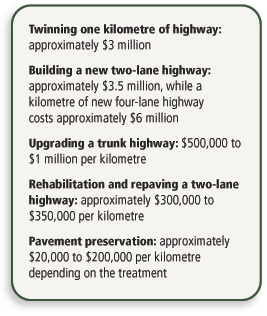
How Are Projects Prioritized?
100 series highways
Major construction upgrades and twinning of our 100 series highways are based primarily on traffic volumes, safety studies, and collision statistics.
For paving projects, the department has implemented a Pavement Management System for 100 series highways in 2010 that involves collecting up-to-date pavement conditions and traffic information on all 100 series highways and uses a pavement management software program that follows nationally accepted guidelines to generate the best possible maintenance and rehabilitation plan. This information, combined with the technical knowledge of highway program staff, is used to develop annual and multi-year paving plans, including various rehabilitation and preservation projects.
Truck routes and local paved roads handling more than 500 vehicles daily
The following factors are used to assess priorities for repaving secondary and local paved roads:
- traffic volumes
- surface roughness
- pavement conditions (cracking, rutting, and broken pavement)
Priorities for pavement preservation projects such as crack and chip sealing are developed by highway program staff who assess the current age and condition of the pavement.
Local low-volume paved roads and gravel roads
The following factors will be considered when determining priorities for surface stabilization projects:
- traffic volumes
- roadside development, including the number of homes, businesses, and community sites (including churches, community halls, recreation centres, parks, etc.) that are located on the road
- requests for road repairs from residents, businesses, not for profit groups, community groups, chambers of commerce and elected officials
Bridges
Provincial bridges are inspected and assessed on an annual basis by Department of Transportation and Infrastructure Renewal engineers and inspectors. Priorities for annual and multi-year bridge rehabilitation and replacement programs are developed by staff considering the condition and age of the structure, the use of the structure, the volume of traffic and weights, and the class of roadway the structure is located on. In all cases, public safety is the primary consideration.
Road building in Nova Scotia
 Road building is an important industry in Nova
Scotia, creating good jobs and injecting millions of
dollars into the economy. An estimated 5,000 Nova
Scotians are directly employed in road building, and
another 2,500 are indirectly employed by the
industry. The annual payroll of Nova Scotians
employed in road building across the province is
approximately $300 million. Each road construction
or maintenance project also brings spinoff benefits
for a variety of support industries, including
construction materials, metalwork/welding,
engineering, electrical, and hazard removal.
Road building is an important industry in Nova
Scotia, creating good jobs and injecting millions of
dollars into the economy. An estimated 5,000 Nova
Scotians are directly employed in road building, and
another 2,500 are indirectly employed by the
industry. The annual payroll of Nova Scotians
employed in road building across the province is
approximately $300 million. Each road construction
or maintenance project also brings spinoff benefits
for a variety of support industries, including
construction materials, metalwork/welding,
engineering, electrical, and hazard removal.
Building and maintaining our roads
Building and maintaining our roads is a significant taxpayer investment.(see right)